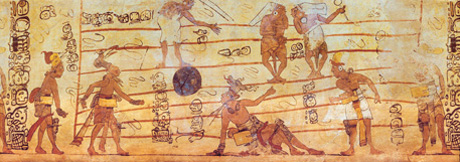Episodes in the Life of Bounce
by Carlin Wing, Cabinet, Issue 56 Sports Winter 2014/15 | To view more photos and read the full article, click here >>
All cultures engage in some form of ball play. Ball games are a basic way for us to hone what computational neuroscientist Beau Cronin calls “the quotidian spatiotemporal genius of the human brain,” and over the past two hundred years, they have come to dominate the popular imagination, with huge swaths of airtime and large volumes of ink given over to the dramas of soccer, basketball, baseball, American football, tennis, golf, rugby, cricket—the list goes on. […]
What follows are some stories drawn from the history of rubber bounce: a series of speculations about sporting cosmologies, creolized technologies, institutionalized play forms, and channeled virtuosities. […]
As early as 1200 BCE in Mesoamerica, the Olmec (Nahuatl for “rubber people”) began building an entire cosmology around the phenomenon of rubber bounce.6 They developed techniques for extracting latex sap from trees and stabilizing it into an elastic material that they used to manufacture a wide range of objects, the first and foremost of which were rubber balls for their ritual ball game and rubber ballplayer figurines that were presented to the gods. The later civilizations of the Maya and the Aztec carried forward and refined the Olmec’s technology and ideology of bounce.7 While the cause of the decline of the Olmec remains unknown, and the decimation of the Maya, Aztec, and Inca by the Spanish and Portuguese has left us with many gaps in our understanding of their material technologies and semantic structures, one thing we do know is that, collectively, these cultures carpeted the region with ball courts. Over fifteen hundred have been excavated to date. […]
The first recorded demonstration of rubber bounce on the European continent took place in 1528, when Hernán Cortés arrived at the court of Charles V with a troupe of Aztec performers in tow. […]
The British and American inventors who took up the material problem of rubber understood themselves as the inventors of a new technology; they were not interested in the Americas as a place from which to learn about bounce, but saw it simply as a site for the extraction of raw materials. […]
Bounce is simply a way to describe a kind of impact. It always only tells us how things are, and how well these things are lined up against our expectations and imaginations of how they should be.
Carlin Wing is a New York–based artist, and a doctoral candidate in the Department of Media, Culture, and Communication at New York University. Iterations of her ongoing project “Hitting Walls” have included a solo exhibition at Anthony Greaney, Boston (2009); a ball-making workshop at Machine Project, Los Angeles (2011); an article in the journal Games and Culture (2014); and a lecture performance at Villa Romana, Florence (2015). She is currently writing a dissertation titled “Bounce: The Material Certainty of Sporting Chance.”
Source: CABINET // Episodes in the Life of Bounce
Address: http://www.cabinetmagazine.org/issues/56/wing.php
Date Visited: Mon Dec 14 2015 19:17:05 GMT+0100 (CET)
[Bold typeface added above for emphasis]
